Seafood spoilage and preservation methods tie closely with seafood safety, sanitation, and the science behind ensuring its quality and freshness. In this comprehensive guide, we'll explore the factors contributing to seafood spoilage, different preservation techniques, and the importance of maintaining seafood safety and sanitation standards.
Understanding Seafood Spoilage
When seafood undergoes spoilage, it deteriorates in quality, becomes unsafe for consumption, and develops unpleasant odors and flavors. This deterioration is caused by various factors, including:
- Bacterial growth
- Enzymatic activity
- Oxidation
- Physical damage
These factors interact with each other and influence the rate at which seafood spoils. Understanding the causes of spoilage is essential for implementing effective preservation methods.
Factors Affecting Seafood Spoilage
Seafood is highly perishable due to its composition and high moisture content. Several factors contribute to its spoilage, including:
- Temperature fluctuations
- Microbial contamination
- Exposure to air and light
- Time lapsed since harvest or processing
Seafood products are also sensitive to handling and storage conditions. Proper handling and storage are crucial in preventing spoilage and maintaining quality.
Preservation Methods
To extend the shelf life of seafood and maintain its quality, various preservation methods are employed:
1. Chilling and Refrigeration
Chilling seafood at optimal temperatures slows down microbial growth and enzymatic activity. Refrigeration maintains the freshness of seafood products, making it a common method for short-term preservation.
2. Freezing
Freezing seafood at low temperatures effectively inhibits microbial growth and enzymatic reactions, extending its shelf life. Proper freezing techniques and storage conditions are essential for preserving the quality of frozen seafood.
3. Canning
Canning involves heat processing seafood in hermetically sealed containers, which effectively sterilizes the product and prevents spoilage. Canned seafood has a longer shelf life and is suitable for extended storage.
4. Drying
Drying seafood removes moisture, inhibiting microbial growth and enzymatic reactions. The resulting dried seafood products have a longer shelf life and require minimal storage space.
5. Smoking
Smoking seafood with controlled temperature and smoke exposure not only imparts unique flavors but also inhibits microbial growth, extending its shelf life.
6. Pickling
Pickling seafood in acidic solutions creates an inhospitable environment for microbial growth, preserving the product and enhancing its flavor.
Seafood Safety and Sanitation
Ensuring seafood safety and sanitation is paramount in the preservation process. It involves adhering to strict hygiene practices, proper handling, and sanitation guidelines. Key considerations for seafood safety and sanitation include:
- Adherence to HACCP (Hazard Analysis and Critical Control Points) principles
- Proper cleaning and sanitization of processing equipment and facilities
- Regular monitoring of seafood storage and handling conditions
- Training of personnel in food safety practices
These measures are essential to prevent contamination and maintain the safety of seafood products.
Seafood Science
The science behind seafood encompasses the study of seafood composition, biochemical reactions, and microbiological aspects. Understanding the science of seafood is vital for implementing preservation methods and ensuring product quality. Key areas of seafood science include:
- Microbiological aspects of seafood spoilage and preservation
- Fundamental principles of food preservation techniques
- Chemical and enzymatic reactions in seafood deterioration
- Biological and physiological changes in seafood post-harvest
By studying these aspects of seafood science, industry professionals can make informed decisions to enhance product quality and safety.

